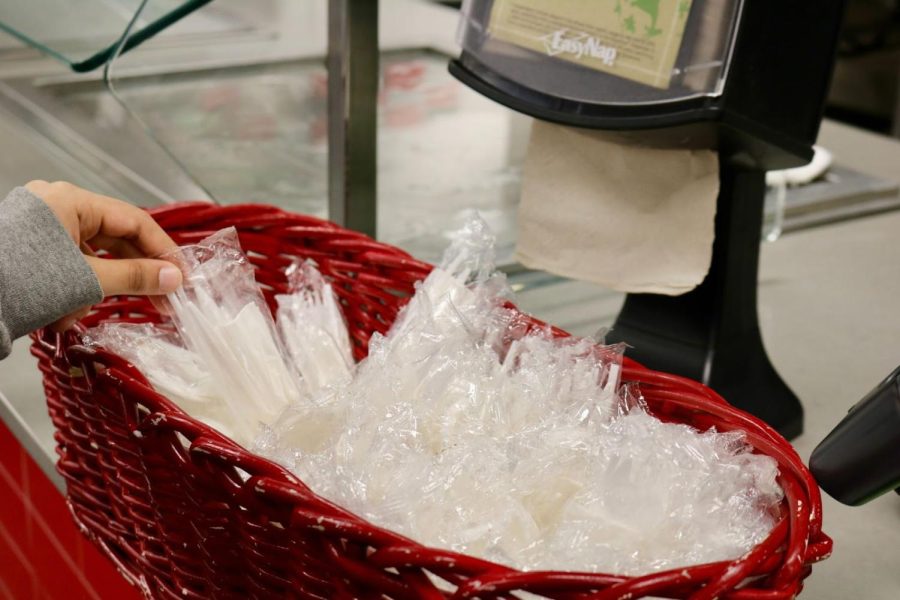Utensils, condiments charged at cafeteria due to a national inventory shortage
Due to COVID-19 fueled inventory shortages, students at Coppell High School are not allowed to freely take utensils without making a purchase from the cafeteria. The restrictions were put into place when students began returning to in-person learning in late 2020, and it is uncertain when they will be lifted.
May 13, 2022
Why aren’t utensils free at the cafeteria?
Students have asked this question throughout the school year as the Coppell High School cafeteria’s utensils and condiments are only provided if a student buys lunch. However, what isn’t understood is the situation of the cafeteria workers, who are coping with an inventory shortage.
“After COVID-19, when everything was quiet for so long and many people were not able to go to work, a lot of manufacturing shut down,” CHS cafeteria manager Stacy Haugh said.
Two major reasons for the restriction on utensils and condiments are due to concerns for contamination and the invententory shortage, both of which sprouted from COVID-19.
The trickle-down effect of the manufacturing system slowing down and distributors low on labor led to cafeteria managers unable to get all the utensils they needed to support the cafeterias.
“There might be times where there’s a good week and then there’s multiple bad weeks where we’re not getting what we requested,” Coppell ISD dietician Haley Werner said.
Due to the shortage, the cafeteria restricted offering utensils freely. Students can only take utensils if they pay for a meal. Currently, the CHS cafeteria distributes around 500 to 1,000 utensils per day.
“For us, when we provide a meal to a student or a snack they’ve come in and purchased, be it a yogurt parfait, cereal, oatmeal or something that requires a utensil, we have to make it our priority to give them what they need in order to be able to eat it,” Haugh said. “We certainly don’t want them eating with their fingers.”
The number of utensils distributed depends on the number of meals provided. This year, CISD has faced an increase from 8,000 to 8,500 meals per day, but are unable to serve enough utensils to support the number.
“There has been more participation, so we’re actually serving more meals with less staff and less products than we ever have,” CISD director of child nutrition Eric Lozano said.
Prior to COVID-19, the CHS cafeterias placed utensil carousels each containing dispensers of forks, spoons and napkins for students to freely use. However, when students returned to in-person learning in 2021, the cafeteria had to quickly adapt and change to the concerns of COVID-19 by removing the utensil carousels and offering wrapped utensils instead.
“We had to completely change things and that’s why you see so many things that are wrapped in bowls with lids and all the cutlery has to be wrapped,” Haugh said. “It increased the volume of things that were needing to be wrapped and [manufacturers] are having a very hard time keeping up with the supply and demand.”
The cafeteria staff was able to adapt smoothly because of the cutlery and condiments inventory from the previous year, but this year they are unable to do so.
Condiments have also faced the shortage issue, especially during Chick-fil-A lunches when the CHS cafeteria provides students with a Chick-fil-A meal. Students repeatedly ask for extra packets of ketchup; however, due to the shortage, the cafeteria is unable to provide students with extra because Chick-fil-A only provides one ketchup packet per meal.
To cope with the situation, Haugh and other cafeteria managers in CISD communicate with each other on a daily basis to try to help each other ease the burden.
“If somebody has an extra of something we try to give it to another school to utilize it,” Haugh said. “So we accommodate one another and try to share inventory.”
In the primary level, schools have opted to a program called “Fork Free Friday,” coordinated by Werner, for a day children eat finger foods.
Implementing solutions is crucial to coping with the situation and the easiest way to cope with a situation continuing the next year is action. The best way to solve the situation right now is for students to bring their own utensils, that’s it.
“Remember that if you’re bringing in at home lunch to try and bring a fork or a spoon,” Haugh said. “It’s not so much that we want to get the word out about; we’re answering questions as to why because it’s been a challenge for everybody.”
Follow Minnie (@mridinigazawada) and @CHSCampusNews on Twitter.











